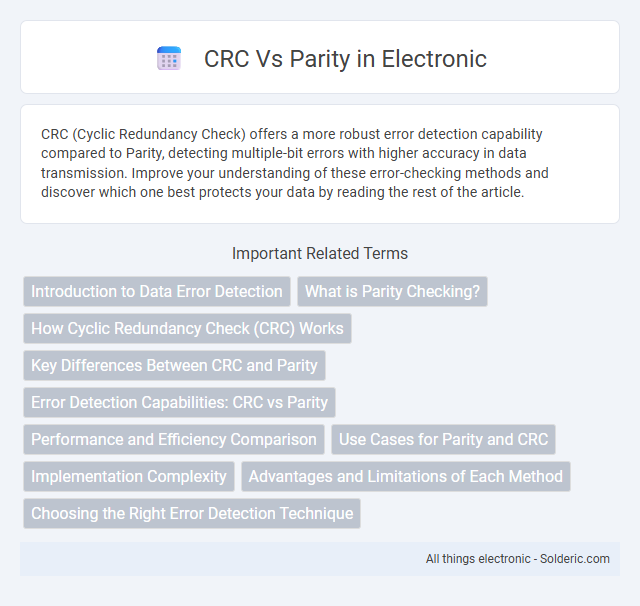CRC (Cyclic Redundancy Check) offers a more robust error detection capability compared to Parity, detecting multiple-bit errors with higher accuracy in data transmission. Improve your understanding of these error-checking methods and discover which one best protects your data by reading the rest of the article.
Comparison Table
| Feature | CRC (Cyclic Redundancy Check) | Parity |
|---|---|---|
| Error Detection Capability | Detects multiple-bit errors, highly reliable | Detects single-bit errors only |
| Complexity | Moderate to high, uses polynomial division | Simple, adds one parity bit |
| Implementation | Requires hardware/software for polynomial calculation | Easy to implement with minimal hardware |
| Error Correction | Only error detection, no correction | Only error detection, no correction |
| Data Overhead | Multiple bits depending on CRC size (commonly 16/32 bits) | 1 bit per data byte or block |
| Use Cases | Network communications, storage devices, file integrity checks | Simple error detection in memory systems, serial communication |
| Performance | High accuracy with slight processing delay | Fast, minimal processing required |
Introduction to Data Error Detection
Cyclic Redundancy Check (CRC) and Parity are fundamental techniques for data error detection in digital communication systems. CRC uses polynomial division to generate a checksum, providing robust detection of burst errors and multiple-bit errors, making it suitable for high-reliability applications. Parity involves adding a single parity bit to data blocks, detecting simple single-bit errors but lacking the capability to identify more complex error patterns.
What is Parity Checking?
Parity checking is an error detection method that adds a single parity bit to a set of data bits to ensure the total number of 1s is either even (even parity) or odd (odd parity). This simple technique helps identify single-bit errors during data transmission, though it cannot detect multiple-bit errors or correct any errors. Your data integrity can be partially safeguarded with parity checking, but more robust methods like CRC (Cyclic Redundancy Check) provide higher error detection capabilities.
How Cyclic Redundancy Check (CRC) Works
Cyclic Redundancy Check (CRC) operates by treating data as a polynomial and performing division by a predetermined generator polynomial, resulting in a remainder that serves as the CRC code. This CRC code is appended to the data before transmission, enabling the receiver to detect errors by performing the same division and comparing remainders. Unlike simple parity checks that only detect single-bit errors, CRC is far more effective at identifying multiple-bit errors, making it essential for reliable digital communication in your systems.
Key Differences Between CRC and Parity
Cyclic Redundancy Check (CRC) offers more robust error detection by using polynomial division to generate complex check values, whereas parity bits provide a simpler, single-bit error detection by indicating whether the number of set bits is even or odd. CRC can detect burst errors and multiple-bit errors, making it suitable for data transmission in networks and storage devices, while parity checks primarily detect only single-bit errors. The computational complexity of CRC is higher compared to parity, but this trade-off ensures enhanced reliability and data integrity in communication systems.
Error Detection Capabilities: CRC vs Parity
CRC (Cyclic Redundancy Check) provides significantly stronger error detection capabilities compared to parity checks by detecting burst errors and multiple-bit errors with higher reliability. Parity bits can only detect single-bit errors and fail to identify errors when an even number of bits are corrupted, limiting its effectiveness. Your data integrity is more securely maintained using CRC, especially in complex communication systems where error resilience is critical.
Performance and Efficiency Comparison
Cyclic Redundancy Check (CRC) offers higher error detection capabilities compared to Parity, making it more reliable for detecting multiple bit errors in data transmission. CRC algorithms, though computationally more intensive than simple parity checks, provide better efficiency in maintaining data integrity in noisy communication channels. Parity checks are faster and require less processing power but are less effective in identifying complex error patterns, limiting their use in high-performance systems.
Use Cases for Parity and CRC
Parity is primarily used in simple error detection for memory systems and communication protocols requiring minimal overhead, effectively identifying single-bit errors. CRC (Cyclic Redundancy Check) is favored in network communications, storage devices, and data transmission where robust detection of multiple-bit errors and burst errors is critical. Parity suits applications with low complexity and speed constraints, while CRC is essential for environments demanding high data integrity and error correction capabilities.
Implementation Complexity
Cyclic Redundancy Check (CRC) implementation requires more complex hardware or software algorithms involving polynomial division, which increases processing time and design intricacy compared to Parity. Parity checks use simple XOR operations for error detection, resulting in minimal hardware requirements and faster execution. CRC provides more robust error detection capabilities but at the cost of higher computational and implementation complexity.
Advantages and Limitations of Each Method
Cyclic Redundancy Check (CRC) offers robust error detection capabilities, effectively identifying common types of data corruption such as burst errors, making it ideal for network communications and storage devices. Parity is simpler and faster to implement, providing basic single-bit error detection with minimal computational overhead, but it cannot detect multiple-bit errors or error patterns where an even number of bits are corrupted. CRC's complexity and processing time are higher compared to parity, which may limit its use in low-resource environments, whereas parity's limited error detection scope restricts its reliability for critical data integrity applications.
Choosing the Right Error Detection Technique
Choosing the right error detection technique depends on the complexity and reliability requirements of your communication system. CRC (Cyclic Redundancy Check) offers a higher level of error detection capability by using polynomial division, making it ideal for detecting burst errors in data transmission. Parity checks, while simpler and faster, are best suited for systems with minimal error likelihood, providing basic single-bit error detection but lacking the robustness of CRC.
CRC vs Parity Infographic

 solderic.com
solderic.com